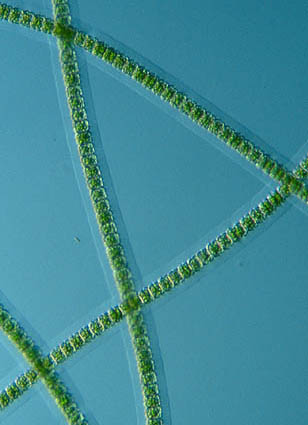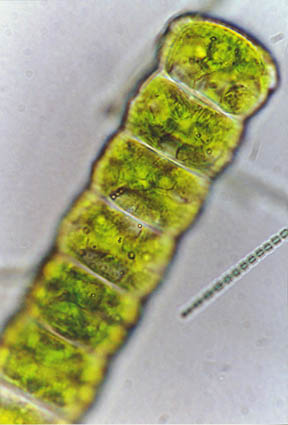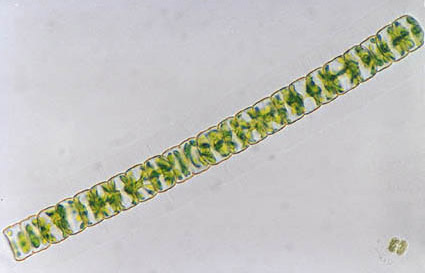 image © Wim van Egmond
image © Wim van Egmond
A number of filaments of Hyalotheca dissiliens in which mucous sheaths are clearly visible.
cell size (L x B): ca 18 x 25 µm
Desmid
of the month
May 2003
Hyalotheca dissiliens
Hyalotheca dissiliens is a colonial, filamentous desmid, rather commonly occurring in all kinds of standing freshwaters, provided that those are not too acid/oligotrophic. Despite its wide distribution the species under discussion is frequently overlooked. Particularly on a superficial view, Hyalotheca may be easily confused with other, non-Conjugatophycean filamentous green algae. The reason is that cells hardly show any morphological differentiaton, such as a distinct sinus, which is characteristic of most desmid species. Moreover, cells join each other across almost their total breadth so that it looks as if we are dealing with a true (parenchymatic) filament rather than with a filamentous colony. Actually, cellular constitution of two semicells appears predominantly from the presence of two large, axile, radiating chloroplasts (one in each semicell). Only on closer inspection a very slight median constriction of the cell is to be distinguished.
Cell filaments of Hyalotheca dissiliens use to be enclosed by a thick mucilage sheath. Such a sheath contributes to the colonial coherence and increases the chance of dispersal as the filaments readily stick to migratory water fowl, insects etc.

image © Frantisek
Hindák
Detail of cell filament. In the upper cells a slight median constriction (sinus) is to be seen.

image © Frantisek Hindák
Cell filament of Hyalotheca dissiliens. The enclosing mucilage sheath (in this picture hardly visible) is about as thick as half the cell breadth.